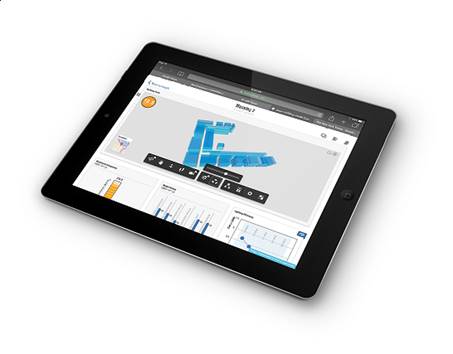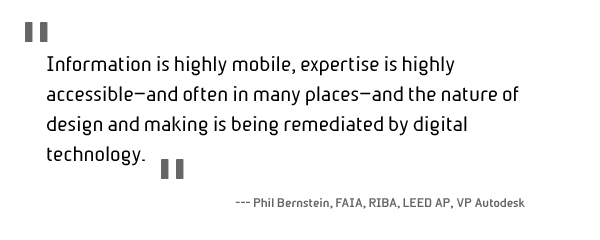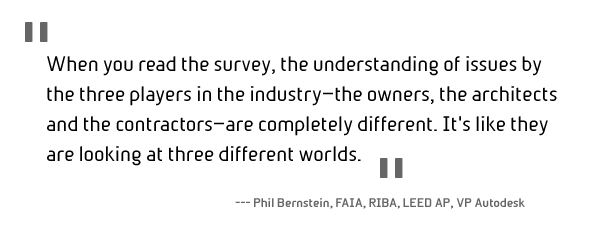According to Michael Monti in the book of essays, “Goat Rodeo: Practicing Built Environments,” Architecture—among the design and engineering fields in AEC—is the most expensive to regulate.
When it comes to accrediting professional schools in colleges, recent data shows architecture programs cost twice as much as landscape architecture and interior design schools, while engineering schools are regulated at one quarter of the cost of accredited architecture schools. Regulating licensure between architects, engineers, and landscape architects is just as unbalanced.
In a series of essays on educating the future generation in architecture Monti ask: “How does the profession train these leaders? It starts with regulatory processes that establish the standards and requirements for education, internship, and examination.”
Yet, despite the high expenditure, industry experts agree that the role of the architect is losing both ground and influence within the AEC industry at large.
The Future of Architecture
In a two-part interview series, Architosh editor-in-chief, Anthony Frausto-Robledo, AIA, LEED AP, had a chance to talk through the challenges facing architects in the 21st century with Phil Bernstein, FAIA, RIBA, LEED AP, Vice President, Strategic Industry Relations, Autodesk and Professor of Professional Practice at Yale’s School of Architecture.
Bernstein is a key essay contributor in “Goat Rodeo” noted above, a vital piece of literature for anyone concerned about how future architects should be educated and trained. An architect and technologist working for the world’s leading software company serving the AEC industry, Bernstein’s particular contributions to “Goat Rodeo” have a unique intensity and reality focus when touching down on the processes and digital tools that are largely guaranteeing a gut transformation of the building industry.
From the perspective of serving a strategic role at Autodesk to his education and training of the next generation of practitioners, at Yale, we begin this discussion by looking at where questions about “role” began.
Part 1—On Roles, Design Intent, Boomers and Construction Logic
(Architosh:) Please explain to me your perspective on the changing role of the architect in the 21st century of making things?
Sure. This existential question—and I think it’s been around for architects for awhile—really predates a lot of the technologies that characterize the discussion we have been having in the 21st century. Because from the 1980’s forward, the role of the architect has been in play, due to the changing nature of the building industry, the paradigms of project delivery, and because the expectations society places on professionals have created a series of open questions.
And these open questions…?
You can trace this discussion all the way back to a book written in the 70’s called “The Reflective Practitioner,” by a guy named Donald Schön. Schön asked a series of questions about what society’s expectations were about professionals, particularly after the failures of expertise during the Vietnam War. Architects have always been rather circumspect about these questions, because we are a relatively small profession and pre-occupied by the projects at hand. So, a lot of the questions about our roles were opened up in the 80’s and 90’s when there was a flood of new project delivery models: CM at risk, design-build, et cetera. And the advent of the liability crisis meant the increased impact of insurance companies defining what architects could and could not do.
In the 21st century we get a couple more factors entering the equation. The architect’s responsibility to sustainability is one of them. The increasing complexity of projects is another. And finally this growing realization in the construction industry of the industry’s inherent inefficiency.
And the impact of the digitization era?
So architects were already asking these questions about their role when we entered the era of intensive digitization, advanced computation, building information modeling, and the internet. So that is what I would call the first wave and now we are at this kind of second wave where we see things through what we call “the future of making things” theory. Information is highly mobile, expertise is highly accessible—and often in many places—and the nature of design and making is being remediated by digital technology.

01 – Autodesk has largely been at the forefront of developing field-based or field-oriented design tools that combine aspects of design tasks for architects with analytics that help them make more informed decisions earlier in the process. FormIt 360 is one such tool. (image: courtesy: Autodesk. All rights reserved.)
And so as architects we need to find our way through that complex web and our place in it.
That is a lot to take in. How does the next generation of practitioners respond to this?
The way I discuss this with my students [at Yale] is to pose an existential question: what role do you want to play?
The problem set for architects has become much more complex. The enterprise of building has become much more complex. In the western paradigm architects are supposed to function as the “head” or integrator of the process, acting on behalf of the owner who wants the building.
If we want to maintain that role that means taking on different kinds of responsibilities and leveraging technology in different kinds of ways. Or—we can just become “design consultants” like graphic designers or interior designers and just be the people who make some space and fix some colors, and choose some building shapes…but I don’t endorse that as the proper professional route.
Okay, so let me jump in here. You have said a lot of interesting things. So, as a licensed architect myself, the way I understand it, the architect’s role from the 20th century point of view has largely been built on this notion that one of the key things we do is define “design intent.”
And so design intent has been this great defensive mechanism on some level for architects because it puts a lot of onus on the builder and his subs to really define things, often at the minute level, for manufacturer and erection, whether in the factory or in the field.
Did you choose the world “onus” intentionally?
Yes, I think so…(laughs…)
It can have a pejorative connotation.
Well, yes, I understand that. I know that there has been a minor cold war between builder and the architect the way we are positioned with our contracts.
I wouldn’t call it a minor cold war. I’d call it a major cold war with some open hostilities.
Okay, fair enough. So, where I am going with this…architects used to be able to define design intent really quite well—with paper and pen. Now with this super millimeter precision that we have with CAD and BIM, how do you see design intent translating into the 21st century?
Right. This is a great question. It’s one I’ve actually written and spent a lot of time thinking about…because there were behavioral norms that created this notion of “design intent” versus “building execution” that existed before the liability crisis of the 1980’s. And there was much lower levels of detail in terms of what the definition of a building was; the number of potential options out there for execution was also much narrower; and the amount of skill per body on the construction site was also much higher. The allocation of “design intent” for the architects and “building execution” for contractors was, originally, more a matter of convenience than risk and responsibility.
So when I was practicing I worked on a few renovation projects here on campus at Yale—some of our older buildings that are probably a hundred years or so old—and got to look at the old drawings, which are beautifully executed. They don’t have a lot of detail compared to normative detailing in the 21st century because builders knew—they just knew what to do. Their options were much more narrow, but there was also much more of a cooperative attitude between design and construction. There wasn’t a zone of contention.
So how did we get to this contentiousness?
The antagonism between architect and contractor was setup purposefully to create a tension that the owner could benefit from. But the waters completely darkened—getting muddy and foul—when you begin to pour the liability crisis into that mix. Owners sue both architects and contractors and that gap between execution and intention was a great place to exploit.
Have you seen this study by McGraw-Hill, called “Managing Certainty and Expectations in Design and Construction”? It was a survey done by the AIA Round Table and a bunch of other folks where they measured the expectations of different players in the building industry—how certain outcomes would be accomplished.
When you read the survey, the understanding of issues by the three players in the industry—the owners, the architects and the contractors—are completely different. It’s like they are looking at three different worlds.
So expectations are off and likely getting worse.
Let’s just stipulate that everyone sees the world differently—there is a lot of tension there. There are expectations about higher precision. There are tools that allow much higher degrees of precision. We are moving from an era where the tools were simply used to make drawings of higher precision to where the tools can now be used to make predictions of higher precision, and also those same tools can drive the physical creation of artifacts much more directly.
We can now take information, that is generated during design, and move it much more directly to the fabrication floor and directly out onto the job site. Do you see the trend I’ve described?
Absolutely.
As architects…do we step into that void or not?
It depends.
I saw a study that showed who the owners of the AE firms were by generation. So you have these Baby Boomers and older generation still spearheading the majority of firms. They are already conditioned around the concept of “design intent” and they are conditioned around the idea that their insurance companies tell them what they can and cannot do. So my next question then becomes: how do you see design intent? Is the concept of design intent ill-advised for architects in practice in the 21st century?
Yeah, absolutely.
And there are two really important reasons why. The idea of “design intent” remains but has to be translated into a different kind of form. First reason is, design intent—as a strategy—is the basis for design generation and resolution. You have to generate and resolve ideas first, you can’t just jump immediately to machine instruction level design ideas.
You have to be able to iterate, create ideas, test ideas, and resolve a design at the level of intent before you can get to more detailed information. So that is design intent issue number one. Number two is—and I suppose it is hypothetically possible through some combination of computing power, big data, machine learning, and experience—the architect has as much understanding about how it all goes together as the builder does, but that is not going to happen in my life time or yours.
That’s a very interesting observation or prediction right there.
So there is always going to be a part of a project that absolutely, necessarily, requires the expertise, the understanding, and interpretation of a builder. It’s not a question of the contentious relationship between the designer and the builder—it’s a question of where does the builder logically insert themselves into the design process?
Advertisement
If you go back to my original thesis, about the architect’s role changing in the evolution of the project delivery model, that was principle number one. Because construction management emerged in the 1980’s, when it was believed by owners and enforced by insurance companies, that things like cost, schedule, and constructibility were things that architects didn’t know enough about. So construction managers appeared earlier in the design process to ensure and warn us about those things.
So we fast forward 35 years and gaining that insight and knowledge into the earlier stages of the design process is really quite interesting and rich.
So the logic of construction is going to be more accessible to the architect as it becomes more digitized.
Yes. But there are challenges. As I’m looking out the window at the house across the street and realizing that even that simple building involves millions of parts and tens of thousands of decisions, many of which will require the insight of a builder. So for me the whole arc here is about co-dependence. It is not about antagonism. And the technology to bridge [that] does not remove the problem nor does it eliminate the idea of design intent. Design intent is the denominator of a design process.
Come back tomorrow for Part 2—On Contracts, Revit’s Brain, Coding, and Architecture Schools






Reader Comments
Interview with Phil Bernstein: Part I https://t.co/WzSksELnQP Look for Part II later today > https://t.co/c7QJYQD2Gu https://t.co/1kxwQWZePp
Phil Bernstein of Autodesk on the Changing Role of the 21st Century Architect—The Interview (Part 1) | Architosh https://t.co/X9Rn9cfXz4
Phil Bernstein of Autodesk on the Changing Role of the 21st Century Architect. https://t.co/bxM7Eb1gMA
.@Bernstein_ADSK on the Changing Role of the 21st Century Architect https://t.co/WzSksELnQP #AEC @architosh https://t.co/pGVTNDzqLY
.@Bernstein_ADSK on the Changing Role of the 21st Century Architect https://t.co/WzSksELnQP #AEC @architosh https://t.co/pGVTNDzqLY
Interview with Phil Bernstein: Part I https://t.co/WzSksELnQP Look for Part II later today > https://t.co/c7QJYQD2Gu https://t.co/1kxwQWZePp
Interview with Phil Bernstein: Part I https://t.co/WzSksELnQP Look for Part II later today > https://t.co/c7QJYQD2Gu https://t.co/1kxwQWZePp
RT @randydeutsch: Interview with Phil Bernstein: Part I https://t.co/WzSksELnQP Look for Part II later today > https://t.co/c7QJYQD2Gu http…
RT @randydeutsch: Interview with Phil Bernstein: Part I https://t.co/WzSksELnQP Look for Part II later today > https://t.co/c7QJYQD2Gu http…
@gm_digiuda @Ciribini @s_mastrolembo Perché gli Architetti si perdono sempre le utili letture: https://t.co/SbxcGjuDuD?
@gm_digiuda @Ciribini @s_mastrolembo Perché gli Architetti si perdono sempre le utili letture: https://t.co/SbxcGjuDuD?
RT @iPracticeIT: @gm_digiuda @Ciribini @s_mastrolembo Perché gli Architetti si perdono sempre le utili letture: https://t.co/SbxcGjuDuD?
RT @iPracticeIT: @gm_digiuda @Ciribini @s_mastrolembo Perché gli Architetti si perdono sempre le utili letture: https://t.co/SbxcGjuDuD?
Phil Bernstein of Autodesk on the Changing Role of the 21st Century Architect—The Interview (Part 1) | Architosh https://t.co/X9Rn9cfXz4
Phil Bernstein of Autodesk on the Changing Role of the 21st Century Architect—The Interview (Part 1) | Architosh https://t.co/X9Rn9cfXz4
RT @iPracticeIT: @gm_digiuda @Ciribini @s_mastrolembo Perché gli Architetti si perdono sempre le utili letture: https://t.co/SbxcGjuDuD?
RT @iPracticeIT: @gm_digiuda @Ciribini @s_mastrolembo Perché gli Architetti si perdono sempre le utili letture: https://t.co/SbxcGjuDuD?
Phil Bernstein of Autodesk on the Changing Role of the 21st Century Architect. https://t.co/bxM7Eb1gMA
Interview with Phil Bernstein: Part I https://t.co/WzSksF2Zfp & Part II https://t.co/w4usmGPydL #architects https://t.co/sRF2a2lSPr
Interview with Phil Bernstein: Part I https://t.co/WzSksF2Zfp & Part II https://t.co/w4usmGPydL #architects https://t.co/sRF2a2lSPr
Comments are closed.